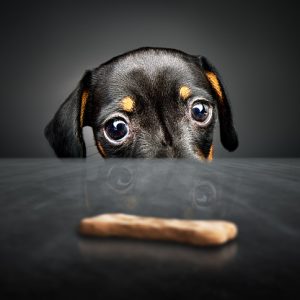 A common complaint people have when training their dogs using food rewards is, “my dog won’t do anything that I ask him to unless I have food in my hand!” Well, first you have to ask yourself if you’ve trained your dog to follow a cue while you’re showing him a piece of food. If you have that food right in front of the dog’s face, your dog will learn food is part of the entire cue for doing that particular behavior. That’s why he isn’t following your request when you omit that part of the cue. Think of that food as a paycheck. Nobody gets paid on Monday morning before they do their job, right?
A common complaint people have when training their dogs using food rewards is, “my dog won’t do anything that I ask him to unless I have food in my hand!” Well, first you have to ask yourself if you’ve trained your dog to follow a cue while you’re showing him a piece of food. If you have that food right in front of the dog’s face, your dog will learn food is part of the entire cue for doing that particular behavior. That’s why he isn’t following your request when you omit that part of the cue. Think of that food as a paycheck. Nobody gets paid on Monday morning before they do their job, right?
Ask your dog to do something simple, like “Sit.” If he sits for you, bring that food out either from behind your back, or from out of the sink, or have someone else hand you that food that was hidden from view. Do a few easy repetitions of having your dog sit, and reward with a treat. Then ask him to do something a little harder, but make sure it is an already-trained behavior. Produce the food reward as I just suggested. This should do the trick with future training.
Figure out what behavior(s) your dog is excelling at, and begin putting that behavior on a “Random Reinforcement Schedule.” Have you ever sat in front of a slot machine? If you have, you know that sometimes the machine pays you, and sometimes it doesn’t. Sometimes we might win 50 cents and sometimes we might win 50 dollars. A random reinforcement schedule is based on the “Slot Machine Principle” which states, “sometimes you get paid and sometimes you don’t!” Atlantic City makes a fortune because of this principle. Trust me, I know because I get hooked every time I’m down the shore 🙁
Keep in mind, however, that if your dog does a behavior perfectly in the kitchen, he needs to learn that same behavior in many different places inside your home. Dogs do not generalize well unless it’s a traumatic experience! Then go outside and begin to train that behavior right near the house, then further down the driveway. You’re now adding the distraction factor to your training.
I’m going to give you a random reinforcement schedule below to help get you started. You can then develop your own random schedules as your dog gets further along with other types of rewards. These subsequent schedules should use less and less food treats and more of other types of rewards. Make a list of all the things your dog loves and use them in your Random Reinforcement Schedules.
Ideas for other types of rewards could be:
- Praise
- A short game of Tug
- A short chase game (he chases you)
- A short game of frisbee
- A chance to chase a squirrel
- Fetching a squeaky toy
- Applause
- Petting
Here are two samples of Random Reinforcement Schedules. The numbers listed are those times that a dog does a behavior in which he is rewarded with food. All other times are rewarded with alternatives.
1, 3, 6, 8, 9, 10, 13, 15, 16,18, 21, 22, 23, 26.
Here’s one more to follow:
2, 4, 7, 10, 12, 13, 15, 18, 19, 20, 22, 25, 26.
